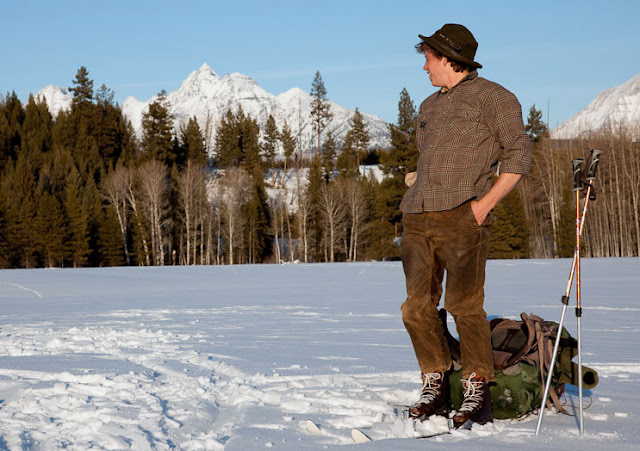I'll be in the backcountry of Glacier National Park for the next four days, for we're taking a break from our normally scheduled programming to revisit the story of my trip into Glacier last winter. I'm heading into this same area again this year, with a few new twists. I'll post more about this year's trip when I'm back in civilization, but for now check out the story and photos below (note: this originally ran on Karhu's blog here).
-----
We set out for a remote corner of Glacier National Park on a sunny late winter morning, GPS and camera in hand, ready to record all of the wild and strange things we could find. Ben and I met here a few winters back working on a forest carnivore study; we spent that winter skiing and tracking together, and no place we explored harbored more odd and grisly findings than the area around Kintla Lake. When the opportunity came to ski back in and survey the area for park biologists, we jumped at the chance. Our friend Travis came along (who’s worked as a fire lookout in a tower on one of the peaks in the background — the same tower as Ed Abbey) and we set out for four days in the wilds to see what we could see.

We ski the sweeping valley-bottom meadows for hours, coming across deer carcasses every few miles. Few people ski into this area, leaving the resident wolf pack with the run of the place. There is also at least one grizzly bear, if not more, here that doesn’t hibernate. We’ve seen its winter tracks before, but found no sign of it on this day.
Travis is part of the new old school. He wears no synthetics and skis in oil-finished tin pants and leather boots. In keeping with the old-school mentality, he also carries a pack the size of a small humpback whale.
We ski along a bench over the North Fork of the Flathead River as the sun set, amid a procession of wolf, moose, and elk tracks. We reach the ranger cabin, our lodging for the night, by headlamp well after dark.
Like many national parks, Glacier has a network of nearly century-old backcountry ranger cabins that are used by rangers, biologists, and others working on wildlife studies. They’re nothing fancy, but they warm up fast and make for ideal rustic accommodations.
Shortly after finding the carcass of a deer that had been eviscerated by a lion, our second day of skiing brings us to the clear waters of Kintla Creek. Our goal for the day is the head of Kintla Lake, still a few miles distant.
The last time we’d skied in to Kintla Lake we arrived to see a pair of wolves running across the lake ice and found a freshly killed deer laying a hundred feet from the front door of the cabin. The wolves howled outside our cabin that night and in the morning the deer carcass was devoured, except for the deer’s head which we found about a mile away. We don’t see wolves on the lake this time, but their tracks are ever-present and bits of deer — legs, hides, ribcages —are always in view as we ski.
We stay quiet and frequently scanned ahead with binoculars, hoping for a glimpse of the carnivores we know are watching us. We hear them yip in the lakeside forest more than once, but never catch sight of them.
The sun sets long before we reach the next cabin at the head of Kintla Lake, but twilight hangs on just long enough for us leave the headlamps in the pack. The last time we stayed in this cabin it was surrounded by grizzly tracks. There’s no bear sign this time, just the invisible presence of wolves and the ghostly hooting of owls as we unlock the door and fire up the wood stove for the night.
To be continued...







.jpg)
.jpg)














No comments:
Post a Comment